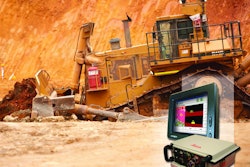By Tina Grady Barbaccia
The Alaska Department of Transportation and Public Facilities (ADOT&PF) in partnership with the University of Minnesota Intelligent Transportation Systems Institute developed a pilot project using an Intelligent Specialty Vehicle System (ISVS) for winter maintenance vehicles. The ISVS is equipped with Precision Global Positioning System (PGPS) technology known as High Accuracy Differential Global Positioning System (HA-DGPS), which is delivered via Real Time Kinematics (RTK) to the vehicle from a single, dedicated GPS base station.
 The vehicle-mounted system has integrated collision avoidance radar technology designed to provide its operator a means to maintain a desired position and avoid collisions with obstacles during periods of low visibility, according to an ADOT&PF “Intelligent Specialty Vehicle System Pilot Program Report” (which is available at http://www.itsdocs.fhwa.dot.gov/JPODOCS/REPTS_TE/14370.htm). The PGPS provides position information to the vehicle, which can be as accurate as 3 cm, according to the ISVS report. In layman’s terms, the system digitally maps the highway. It also digitally maps the location of the centerlines, fog lines, pullouts, and guardrails — any feature on the highway. The system also maps digital airspace so an operator is aware of mountains and other landmarks.
The vehicle-mounted system has integrated collision avoidance radar technology designed to provide its operator a means to maintain a desired position and avoid collisions with obstacles during periods of low visibility, according to an ADOT&PF “Intelligent Specialty Vehicle System Pilot Program Report” (which is available at http://www.itsdocs.fhwa.dot.gov/JPODOCS/REPTS_TE/14370.htm). The PGPS provides position information to the vehicle, which can be as accurate as 3 cm, according to the ISVS report. In layman’s terms, the system digitally maps the highway. It also digitally maps the location of the centerlines, fog lines, pullouts, and guardrails — any feature on the highway. The system also maps digital airspace so an operator is aware of mountains and other landmarks.
The vehicle-mounted systems were originally installed in two test vehicles: a 1994 Oshkosh snow blower and a 1998 Freightliner 6×6 snowplow. The equipment was eventually installed newer 2006 trucks when the those vehicles were purchased.
“This Heads-Up display [also referred to as a “smartplow”] is the most technologically advanced system we are using,” says Michael J. Coffey, statewide maintenance and operations chief for ADOT&PF. A glass display with the digital map drops down right in front of the snowplow operator on equipment equipped with the system.
“Every feature on the highway is digitally mapped,” Coffey explains. “It’s really amazing. You know where the intersections are, you know where the center dividers are, and even the snow poles, guardrail, and pullouts on highways.”
If an operator starts going too far to the right and crossing over the fog line, [the fog line on the display] starts turning red. If the centerline is crossed, it will turn red. A seat shaker is also tied into the system to help guide operators, he says. “If you cross the fog line, the right side of the seat shakes,” Coffey explains. “If you cross the centerline, the left side shakes. You also get a visual because the line turns red. Another feature that is available, but not currently installed, is an audio where an alarm or horn can go off.”








